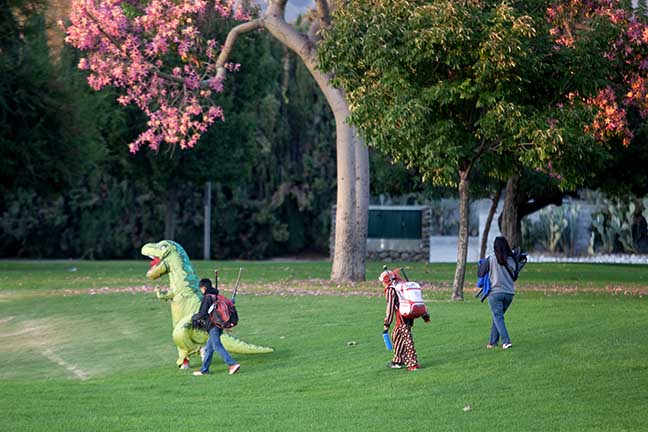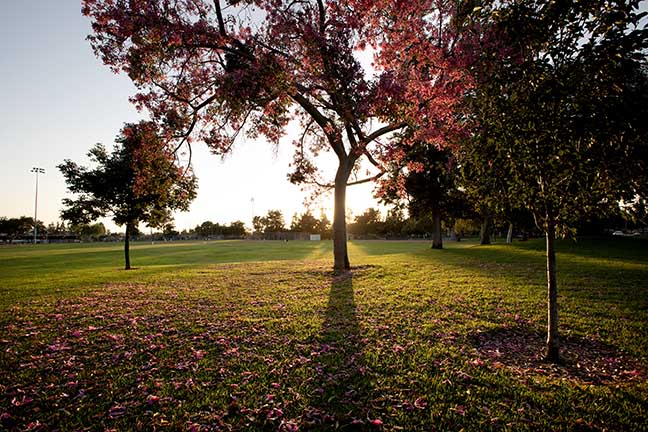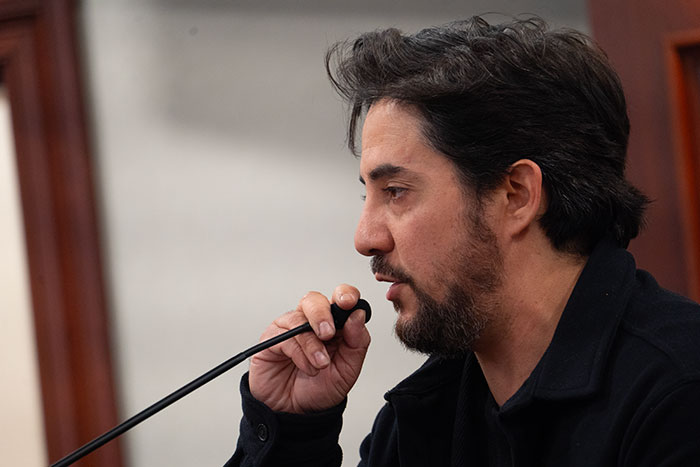Council uses Tongva word for ‘snowy mountain’ to rename Cahuilla Park

Members of the Juggernaut baseball team make their way to one of the ballfields at Cahuilla Park on Tuesday. The Claremont City Council voted unanimously during its meeting Tuesday to rename the park “Joāt” which is the Tongva name for both Mount Baldy and snow. Courier photo/Steven Felschundneff
by Steven Felschundneff | steven@claremont-courier.com
Tuesday evening the Claremont City Council corrected a misunderstanding that some Native Americans have sought for over 10 years.
The council voted unanimously to change the name of Cahuilla Park to “Joāt” which is the Gabrielino-Tongva word for Mount San Antonio, also known as Mt. Baldy.
“Joāt means both ‘snow’ and ‘snowy mountain.’ Today we call that mountain, Mt. Baldy and Claremont is the place below Mt. Baldy. The Tongva knew it as The Place below Joāt: Torojoatngna,” according to author William McCrawley.
In 1963 Cahuilla Park, located at Scripps Drive and Indian Hill Boulevard, was named to honor the Cahuilla Indians, who were believed to be the longest standing Indigenous inhabitants of what we now call Claremont. However, many now maintain the Tongva were the real tribe that lived here, and in 2012 an effort to rename the park to more accurately represent the area’s Indigenous peoples was launched.
To adopt a suitable name a community group was formed that included Al Villanueva, Marilee Scaff, Ginger Elliott, and Mark Acuna. That group decided the best path forward was to name the park after a botanical feature native to Claremont rather than any of the Indigenous tribes that may have been present in the area. The committee’s recommendations included sage, western sycamore and elderberry.
In April 2012 the Community and Human Services Commission reviewed changing the park’s name, including the suggestions from the committee, but ultimately rejected the idea. On May 8, 2012 Claremont City Council agreed, unanimously voting not to change the name, and the idea was put aside.
In August, 2020 at a special meeting of the city council regarding the COVID-19 pandemic, members of the public requested that the city once again consider renaming the park “to more accurately represent the early inhabitants of the Claremont area.”
City staff asked UC Riverside professor Wallace Cleaves, who is a member of the Gabrielino-Tongva Native American tribe and Kimberly Morales Johnson, tribal secretary with the Gabrielino-Tongva San Gabriel Band of Mission Indians, to provide the historical context necessary to adopt a suitable name.
In October 2020 the Community and Human Services Commission formed an ad hoc committee to discuss renaming the park. Over the past couple of years that committee met with Cleaves and Johnson as well as other community members and came up with six Tongva names that would be suitable for a park in Claremont.
During its meeting three weeks ago the commission quickly narrowed the list of potential names down to the top three: “Kasili,” white sage, “Joāt,” Mt. Baldy and “Hu’ utok Joat,” Baldy view. The commissioners expressed a need to choose a name that was both appropriate and would not be too difficult for English speakers to pronounce.
“We are trying to find a happy medium of a meaningful name but at the same time one that can be more easily adopted into the community,” chair Dirk Silva said during the meeting.
“This movement of renaming spaces and giving it back to Native American people is what is really happening throughout the U.S. right now,” tribal secretary Johnson said during public comment.
She recommended selecting Kasili because, “White sage has historical significance and its currently threatened in the wild because its being poached.”

The Claremont City Council voted unanimously Tuesday evening to rename Cahuilla Park, seen above, to Joāt Park, which is the Tongva name for both Mount Baldy and snow. Courier photo/Steven Felschundneff
After Villanueva suggested Joāt, the commission elected to send both names to the city council for the final decision, in part because there were just two public speakers and the commissioners felt it would be wise to receive more community input.
During his council presentation on Tuesday, Community Services Director Jeremy Swan noted that some Indigenous peoples had contacted his department to express some doubt that Kasili was actually the name for white sage and might be applied to other types of sage as well.
Every speaker during public comment, including Johnson, Cleaves and Villanueva, endorsed naming it Joāt Park.
“There is not a standard phonetic rendering of the word but ‘ywaat’ was produced by the noted ethnologist [John P.] Harrington, and seems to be the most likely to produce a correct approximation of how the word should be pronounced,” Cleaves said in an email on Wednesday. “Joāt is the commonly used spelling in contemporary orthography though ywaat is also used.”
Cleaves provided a SoundCloud recording for anyone wanting to get the pronunciation just right.
“It was produced by UCLA professor Pam Munro who facilitates the Tongva Language group and is likely the most prominent academic scholar of the language,” Cleaves said.
On Wednesday, Swan, the community services director, said he was still working on a timeline for when the signage at the park will be changed as well as the directional signs around town that lead visitors to the park. There is also a plan to install a historical plaque. He said the marquee signs should be fairly easy to alter because the current letters can simply be removed, the sign thoroughly cleaned and then the new letters applied.
The staff report said the changes should cost about $3,500, and that the city will also be holding a yet to be scheduled ceremony to recognize and celebrate the change.
1 Comment
Submit a Comment
You must be logged in to post a comment.










Unfortunate word. Why not just Tongva Park?